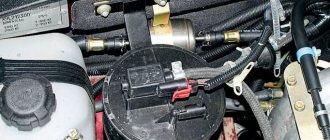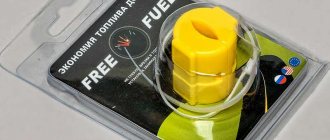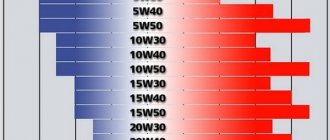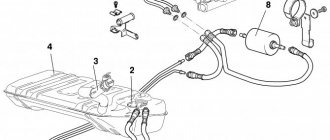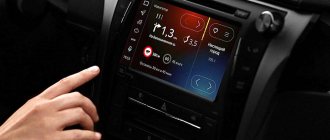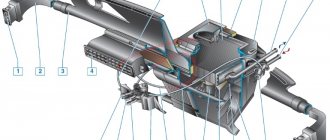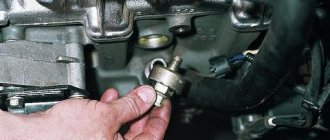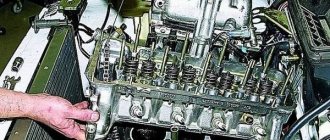What is the Niva's fuel consumption?
As mentioned above, the Niva has been in production for a little over 40 years and has undergone many changes. Fuel consumption also changed with these changes due to the transition from carburetor fuel injection to fuel injection, and after modifications to new engines.
Also, fuel consumption is an average indicator and depends on the driver’s driving style, the terrain through which the car is moving and the ambient temperature.
The manufacturer provides average fuel consumption readings for the Niva, which were measured at special stands and test sites. The average fuel consumption on a Niva, regardless of engine type, is as follows:
- City – 12 liters per 100 km;
- Highway – 8.5 liters per 100 km;
- Mixed cycle – 10 liters per 100 km;
As a rule, these indicators often differ from real ones. On carburetor engines, fuel consumption is always slightly higher than on injection engines. And it depends on the operating conditions of the car.
Niva - table of fuel costs for different brands.
The table describes average fuel consumption for different brands of Niva . Fuel consumption is presented in three types - city, highway and mixed (average) fuel consumption. All data on fuel costs are from the Niva car manufacturer. For almost all brands of Niva, fuel consumption does not exceed 15 liters per 100 km.
| Niva brand | Niva fuel consumption, liter/100 km |
| Niva 21213 (1.7 liter, carburetor) | City=13.0 Off-road=15.0 Route=10.0 Mixed mode=12.5 If the carburetor malfunctions, fuel consumption can double! |
| Niva 21214 (engine 1700, injector) | City=11.0 Route=8.5 (speed 80-100 km/h) |
| Niva S Chevrolet (1700, injector) | City = 14 Track = 8.6 (speed 100 km/h) Route=12 (speed 120 km/h) Mixed mode = 10.8 |
| Niva 2131 five door (engine 1800, injector) | City=15 Route=10 Mixed mode=12.3 liters of fuel |
| Niva 2131 five door (1700, injector) | City=12.8 Route=9.5 Mixed mode=11.0 liters of fuel |
We reduce consumption. Video!
Consumption of VAZ 2121
Niva 2121 is the very first ever released, produced from 1977 to 1993 and equipped with a carburetor injection engine that developed 80 hp. and 116N*m of torque. Such technical indicators were not impressive; the Niva turned out to be “slow,” but it had enough power to move over rough terrain. The engine power allowed the Niva to accelerate to a maximum of 130 km/h, and then in a huge period of time by modern standards. Acceleration to 100 km/h for this modification was approximately 20 seconds.
Consumption per 100km
- City - 13 liters;
- Highway – 8.1 liters;
- Mixed cycle - 9.9 liters;
VAZ 21213
This model is another modification of the base Niva 2121. This time, the manufacturers made changes to the aerodynamic parameters of the car and tried to reduce fuel consumption. Production of this car began in 1993 and continued until 2007.
In the appearance of the car, new taillights appeared, the bumpers received a slightly different shape, and the interior became more modern. Niva 21213 was equipped with four-cylinder engines with a volume of 1.7 liters and a power of 82 hp. Fuel was supplied using a new two-barrel Solex carburetor. The car was driven using a traditional five-mode manual transmission. Such changes allowed 21213 to accelerate to 160 km/h. But the main thing is that this Niva has become much more economical.
| Engine | Consumption (city) | Consumption (highway) | Flow (mixed) | Type of fuel |
| 1.7 MT 82 hp (Mechanics) | 12.1 | 8.5 | 10.2 | Petrol |
Consumption VAZ 21213
This modification is a reworking of the old body. In 21213, the rear part was changed, making a third door of a larger size and changing the lights to original ones (previously, the Niva used lights from the VAZ 2106). The car has been produced since 1993 until now; during all this time, only the bumpers and engine have changed in the car. At the beginning of production, the Niva was equipped with an engine with a Solex carburetor, which increased engine power to 82.5 hp. Later this model was switched to an injector.
Consumption per 100 km with carburetor engine
- City - 11.4 liters;
- Route – 8.5 liters;
- Mixed cycle - 9.4 liters;
Consumption with injection engine per 100 km
The injection engine received a larger volume of up to 1.7 liters and, therefore, its power also increased to 83 hp.
- City - 11.2 liters;
- Highway – 8.2 liters;
- Mixed cycle - 9.8 liters;
The fuel consumption of a cornfield depends on the driving cycle.
The fuel consumption of a Niva car depends on the cycle - in the urban cycle, the Niva spends about 11 l/100 km, in the suburban mode (speed 90 km/h) it spends 8.7 liters of fuel, in mixed mode the Niva consumes 10.8 liters. Depending on the type of driving, the fuel consumption of a Niva vehicle may vary. The exhaust gases from the NIVA vehicle meet the requirements of the Euro-2 toxicity standard.
Also interesting: Air conditioning on a Chevrolet Niva » All about Chevrolet, Chevrolet, Photos, videos, repairs, reviews
Consumption VAZ 2131
This modification was released in the mid-90s and gained its popularity. In this model, the number of doors has increased from 3 to 5, which increased comfort and ease of use. The engines were naturally inherited, which affected the decrease in their performance due to the increase in the weight of the car.
Fuel consumption per 100km
- City - 14 liters;
- Highway – 9.1 liters;
- Mixed cycle – 11 liters;
Fuel consumption. According to the passport and in reality.
According to the manufacturer’s technical documentation, gasoline consumption on a Niva 21213 carburetor is expressed in the following figures:
| Engine | Consumption (highway) | Consumption (city) | Consumption (mixed cycle) |
| 1.7 | 5 l/100 km | 9.6 l/100 km | 9.3 l/100 km |
The actual fuel consumption of the VAZ 21213 per 100 km will differ slightly from the declared one. This data depends on many factors. For example, in winter, fuel costs increase and reach 15-16 liters per hundred kilometers
. In summer, the figures drop to 10-12 liters. Increased fuel consumption is caused by poor condition of the carburetor and chassis of the VAZ.
The fuel consumption of the VAZ 21213 per 100 km is also influenced by the speed at which the car moves, the year of its manufacture and many other factors, from the condition of the road surface, the correct selection of car tires and their wear, to the driving experience of the driver himself. Off-road gasoline consumption on a VAZ 21213 carburetor, even a new one, will consume 20-30 liters of gasoline.
Consumption Niva Chevrolet
This model was produced by the concern together with the American one. The first models were released in 2002 and were produced without changes until 2009. Restyling appeared in 2009 and greatly changed the appearance of the car. The modified car began to look much more interesting and modern, in no way inferior to modern crossovers.
Fuel consumption on this model depends on the year of manufacture and the engine installed on the car. In the pre-restyling version there were two types of 80 hp engine. and 125 hp
Average fuel consumption
ICE 80 hp volume 1.7 liters
- 11 liters per 100 km with an average cycle;
ICE 125 hp volume 1.8 liters
- 10.5 liters per 100 km with an average cycle;
Fuel consumption of Chevy Niva (2009 onwards – to date)
- 10.2 liters per 100 km combined cycle;
It's important to remember this
Never skimp on the quality of fuel, you will regret it more than once, because low-quality raw materials, when entering a car, disrupt quite a lot of processes, making the car faulty. So, you immediately ruin the car and increase fuel consumption due to these breakdowns. There will be no savings from this; rather, organizing a trip that is too expensive. In any case, the fuel consumption standards of the Niva 2121 injector will not allow you to save much.
Also interesting: Changing the oil in a Chevrolet Niva gearbox
When choosing a car for yourself, choose one that will have low consumption and an average price for the car itself. It is also worth considering the cost of maintenance; parts for certain brands are too expensive.
What affects fuel consumption
Fuel consumption is difficult to make ideal, since it is influenced by a huge number of factors such as:
- The terrain through which the vehicle is moving;
- Wear of engine parts;
- Fuel quality;
- Ambient temperature;
- Turning on additional electrical equipment (heated glass, air conditioning), etc.;
To reduce fuel consumption, try not to speed up more than 90 km/h, reduce the use of air conditioning, maintain the frequency of the fuel system, and change the filter in a timely manner.
Summing up
Before purchasing, you should always consider gas mileage and the approximate cost of maintenance. SUVs themselves are expensive cars, and not everyone can afford such a car. Basically, for city driving, small runabouts will be the most budget-friendly option.
Their circulation cycle in the cooling system warms up very quickly and consumes little fuel, which makes them very affordable and economical in winter. Cars need to be roughly divided into groups and bought the one that is ideal for you, depending on the purpose and territory of driving. Based on your personal financial capabilities, you need to understand which model you can afford and what exactly you want.
Read news about the new Niva
- The most powerful cars with naturally aspirated engines
- UAZ or Niva - which is better, car characteristics and features ::
- How to reduce Niva fuel consumption
- How to reduce Niva consumption
- The modernized Lada Niva Legend (4x4) 2021 was shown on the Internet
- Lada 4×4 Bronto - sales stopped, new details » Lada.Online - all the most interesting and useful about LADA cars
- Description of the instrument panel Lada 4×4 (VAZ 2121, 2131) » Lada.Online - all the most interesting and useful about LADA cars
- LADA Niva – Operating manual – Official LADA website
Chevrolet Niva
This model was a joint development of the Russian company AvtoVAZ and the American corporation General Motors. The car is considered domestic, but is produced under the foreign Chevrolet brand.
Cars under this name have been produced since 2002 and are a sought-after product on the Russian automobile market. All-wheel drive is provided as standard. On the Chevrolet Niva, the main engine is a four-cylinder 1.7-liter gasoline unit with a capacity of 80 horsepower. The transmission is mechanical, five-speed. Maximum speed – 140 km/h.
In 2009, minor changes were made to the appearance of the model, but the technical characteristics remained the same. In 2021, AvtoVAZ planned to discontinue the Chevrolet Niva from production and replace it with another all-terrain vehicle, but the project of a new generation Niv was suspended.
| Engine | Consumption (city) | Consumption (highway) | Flow (mixed) | Type of fuel |
| 1.7 MT 80 hp (Mechanics) | 14.1 | 8.8 | 11.2 | Petrol |
| 1.8 MT 125 hp (Mechanics) | 12.7 | 8.4 | 10.3 |
The given digital indicators of fuel consumption cannot be considered an unshakable norm. The actual consumption of gasoline or diesel by a specific car can only be determined experimentally. In addition, how many liters of fuel a car will consume per 100 kilometers depends on the period during which it is on the road. In summer these indicators will be the same, but in winter they will be completely different. Fuel consumption is also affected by the driver's driving style and the condition of the road surface.
Financial costs for the car's gluttony can be reduced by switching it to gas, but in this case you will have to sacrifice free space and speed performance.
Fuel consumption of Niva Chevrolet per 100 km according to the passport
Fuel consumption of AI-95 with Euro-2 engine, l/100 km:
- City - 10,8 ;
- Highway, 5th gear (90 km/h) – 8,6 ;
- Highway, 5th gear (120 km/h) – 11,6 .
Now let’s study the figures typical for Euro-5 internal combustion engines and valid from 10/1/2015:
- City - 14,1 ;
- Route – 8,8 .
Progress bears fruit. Engine power remains the same, but fuel consumption per 100 km for the Chevrolet Niva increases.
Too many auxiliary units...
All figures are published by the manufacturer himself. By the way, the air conditioner was not taken into account here.
According to reviews from owners, the official data is very close to reality - the difference is no more than 5%. Some people managed to “burn” 20 liters, but such cases must be dealt with separately.
Fuel consumption Lada 4×4 2121 Niva 1977, jeep/suv 3 doors, 1st generation
| Engine capacity | Power | Transmission | Drive unit | Fuel | Consumption |
| 1.7 l | 83 hp | Manual transmission | four-wheel drive (4WD) | Gasoline AI-95 | 9,9 |
| 1.7 l | 80 hp | Manual transmission | four-wheel drive (4WD) | Gasoline AI-95 | 9,9 |
| 1.6 l | 80 hp | Manual transmission | four-wheel drive (4WD) | Gasoline AI-92 | 10,0 |
| 1.6 l | 73 hp | Manual transmission | four-wheel drive (4WD) | Gasoline AI-92 | 10,0 |
| 1.7 l | 79 hp | Manual transmission | four-wheel drive (4WD) | Gasoline AI-92 | 10,5 |
| 1.7 l | 83 hp | Manual transmission | four-wheel drive (4WD) | Gasoline AI-95 | 12,0 |
Features of consumption on Niva
First of all, let’s look at what parameters the manufacturer himself indicated in the technical documentation.
According to the stated technical specifications, in urban driving mode, 12.1 liters of gasoline will be consumed per 100 km. If you use a car outside the city, this figure will be much lower. The technical specifications indicate a value of 8.3 liters of gasoline per 100 km on the highway. In addition, the manufacturer claims that with mixed driving mode (i.e. both in the city and outside the city), gasoline consumption will be 10 liters.
Niva 4×4 is equipped with an injection engine. Thanks to this, gasoline consumption in this car is slightly lower than in Niva models with carburetor engines. The latter, according to technical specifications, can consume up to 13.5 liters of gasoline per 100 km. Consumption on an injection engine, according to the technical documentation from the manufacturer, is only up to 9.1 liters of gasoline per 100 km. However, car owners assure that you should not rely heavily on these figures.
A large number of reviews indicate that consumption on a Niva 4x4 can often reach 14 liters of gasoline per 100 km. And this despite the fact that the car does not have any serious faults.
Niva 2121
This variation of the Niva was put on the assembly line between 1977 and 1993. There is a standard 1.6 4-cylinder engine with a power of 80 horses. The maximum speed for this engine is 130 km/h.
As for the characteristics of gasoline consumption, the following values are noted:
- When driving on the highway - 7.7-7.9 l;
- In urban conditions - 13.2-13.8 l;
- In the combined cycle on the highway and in the city - 9.6-9.9 liters.
Models with such technical characteristics are still in service and are often found on the roads. The reason for this is the low fuel consumption of the VAZ 21214.
